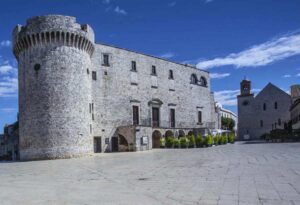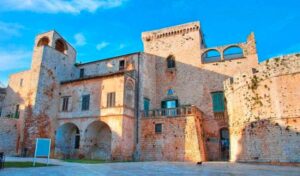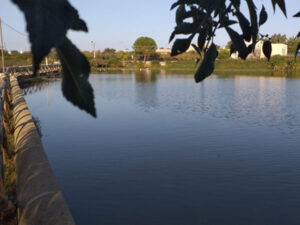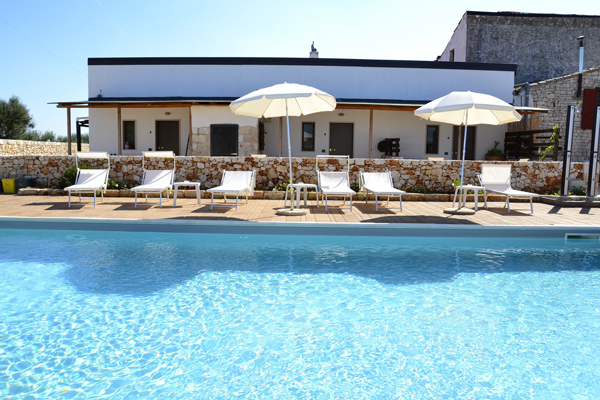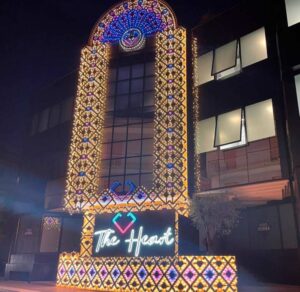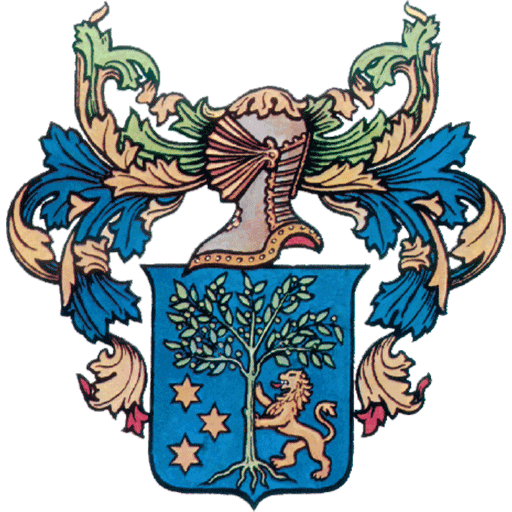Conversano
Index
Where is Conversano located?
La città sorge su una dolce collina a 219 s.l.m., domina il territorio circostante sino al mare Adriatico che dista circa 6 km. Il paesaggio intorno è quello tipico della Puglia, molto verde, per la presenza di frutteti, uliveti, vigneti, mandorleti e soprattutto ciliegeti destinati all’esportazione. Confina a Nord col comune di Mola, a Nord-Est con Polignano, a sud-est con Castellana, a sud con Putignano, a sud-ovest con Turi e a nord-ovest con Rutigliano. La superficie del territorio (127 km²) è una tra le più estese del sud-est barese. All’interno del suo territorio sono presenti due isole amministrative (“enclavi”) appartenenti territorialmente al comune di Polignano a Mare.
What to see in Conversano?
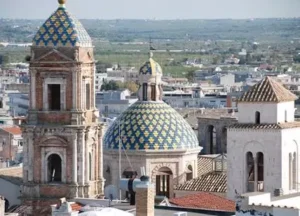
Land of colors, scents, majestic monuments and historic alleys.
The CONVERSANO CASTLE overlooks the hill, the beating heart of the city, the residence of the Acquaviva d’Aragona family, a site of history and legends to be listened to and explored with curiosity.
The PINACOTECA, residence of the famous canvases representing the “Jerusalem Liberated” written by Torquato Tasso and painted by Paolo Finoglio.
The Cathedral of Conversano also overlooks Piazza Castello. In Apulian Romanesque style, it is a very characteristic building made entirely of white stone with a beautiful rose window in the central part of the facade. The Cathedral is perfectly intact thanks to the restoration works that have given it the splendor of its origins.
The CATHEDRAL BASILICA, a typical example of Apulian Romanesque, home of the icon of the MADONNA DELLA FONTE, patron saint of Conversano.
What to eat in Conversano? Where to eat in Conversano?
A typical product of the Conversanese land is the CHERRY, the red fruit par excellence and the unmistakable heart shape, the succulent flavor and the smell that emanates at the first bite the queen of the varieties of cherries: the RAILWAY.
What to do in Conversano?
In spring, “Maggio Conversanese” takes place, a festival that revolves around cultural and entertainment events such as the “Cherry Festival”, a well-known anniversary and an opportunity to taste typical local products
Vuoi assaggiare i piatti tipici della cucina di Conversano? prenota ora il tuo tavolo!
CHURCH AND CONVENT OF SS. DOCTORS COSMA AND DAMIANO
Negli anni trenta del Seicento il conte Giangirolamo II Acquaviva d’Aragona (Il Guercio di Puglia) e la consorte Isabella Filomarino commissionarono il rinnovamento dell’antica chiesa romanica di San Matteo, intitolando il nuovo complesso ai Santi Medici Cosma e Damiano, a cui i conti erano particolarmente devoti, avendone ricevuto una grazia.
L’edificio preesistente fu sottoposto ad un totale rifacimento secondo lo stile barocco, e l’incarico dell’integrale riprogettazione dell’apparato decorativo interno, fu affidato al pittore napoletano Paolo Finoglio. Egli, morto prematuramente nel 1645, non vide mai compiuta l’opera, proseguita dai suoi allievi; la chiesa fu poi consacrata nel 1660 dal vescovo Giuseppe Palermo.
L’esterno si presenta estremamente sobrio, con muratura compatta e uniforme in pietra calcarea (quasi ispirandosi all’antico stile romanico). La facciata presenta cordoli che la percorrono orizzontalmente e, in asse con il portale di ingresso, una grande finestra con lesena, il cui modello è ripreso dalle più piccole finestre sul prospetto laterale (all’intersezione con Corso Umberto). Il campanile è a due ordini, in mattoni.
Visit our Bed & Breakfast in Conversano where to stay in order to visit it
The history of Conversano:
The ancient NORBA
The origins of the city date back to the Iron Age at the latest, when the indigenous peoples, iapige or peucete, founded a city named Norba on a hill higher than the surrounding area and endowed it with mighty stone walls (the toponym, not unique in Italy, in fact it would mean “fortified city”).
The city had a happy location, placed as it was along an important road axis. This soon made it a thriving settlement, at the center of trade between the Magna Graecia colonies of the coast and the indigenous peoples of the interior. The large necropolis dating back to the 6th century BC. in fact, it has returned dozens of tombs with rich funerary objects, partly of Hellenic origin.
In 268 BC, with the extension of Roman hegemony in Peucezia, Norba also lost its autonomy; nevertheless, it maintained an important role, as evidenced by the conspicuous findings of coins, armor, terracotta artifacts and jewels, thanks to the archaeological excavations carried out inside and outside the walls. The Peutingerian Table itself reports the toponym Norba, but the town did not survive the dissolution of the Western Empire, presumably by the Visigoths of Alaric who passed through Apulia in 411.
Visit our B&B in Conversano where to stay in order to visit it
Middle Ages
Already starting from the fifth century AD, not long after the presumable disappearance of Norba, and in the same place, the sources attest to the existence of the toponym Casale Cupersanem, which probably was a bishopric since the seventh century. In 949 the Annales Barensis attest to the action taken by the Platipodi hamlet on the siege of Conversano.
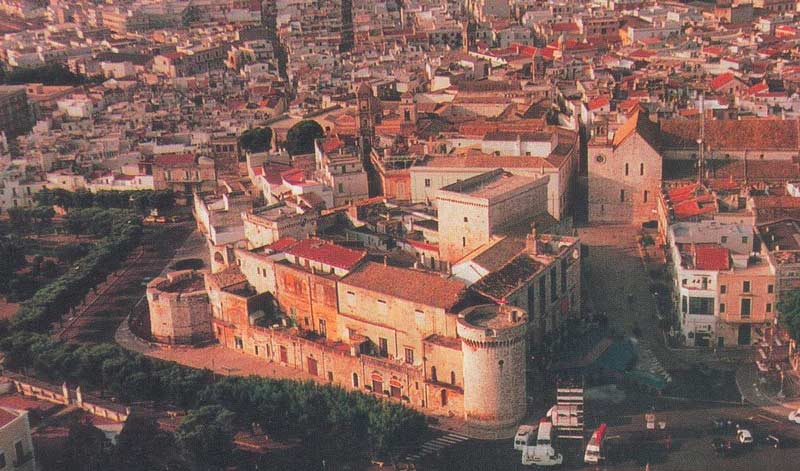
Ma fu dalla metà dell’XI secolo, con la dominazione normanna delle regioni meridionali della penisola italiana, che il luogo assurse a vero e proprio centro di potere: intorno al 1054 Goffredo d’Altavilla nipote di Roberto il Guiscardo, prese il titolo di comes Cupersani e fece della cittadina il fulcro di un’amplissima contea, estesa per buona parte della Puglia centro-meridionale, tra Bari e Brindisi e fino a Lecce e Nerito (Nardò). L’importanza della corte conversanese nel panorama nobiliare di quegli anni è ben attestata dall’aver ospitato a Conversano per alcuni mesi il duca di Normandia Roberto II detto il Cortacoscia, figlio del re d’Inghilterra Guglielmo il Conquistatore, che era di passaggio in Puglia al termine della prima crociata; Roberto II sposò anzi Sibilla, figlia di Goffredo, e ricevette una dote ampia abbastanza per riscattare l’ipoteca di 10.000 ducati sul ducato di Normandia accesa prima della partenza per la Terrasanta.
The rise of the Acquaviva d’Aragona
L’ultimo conte Orsini del Balzo era Giovanni Antonio, figlio di Raimondo principe di Taranto e di Maria d’Enghien (che poi avrebbe sposato in seconde nozze Ladislao I d’Angiò). Giovanni Antonio diede in dote l’intera contea di Conversano – che comprendeva i centri di Castellana, Casamassima, Castiglione (centro abitato poi scomparso, tra Conversano e Castellana), Noci e Turi – a sua figlia Caterina, sposa del duca d’Atri Giulio Antonio Acquaviva. Iniziava così nel 1455 il lungo possesso del feudo di Conversano da parte della casata degli Acquaviva che, salvo una parentesi di quattro anni, lo avrebbe detenuto ininterrottamente sino all’abolizione dei diritti feudali del 1806.
Giulio Antonio Acquaviva, considered by his contemporaries to be a talented leader, distinguished himself above all in the battle of Otranto against the Turks (1481). That same year he died in battle due to an ambush, leaving the estate as an inheritance to his son Andrea Matteo. He too excelled in numerous battles; his heroic behavior earned him the recognition, by the king of Naples Ferdinando I, of the privilege of adding the royal one to his family’s weapon and of changing his surname to Acquaviva d’Aragona. His fortunes at court, however, were clouded by the accusation of having taken part in the so-called conspiracy of the barons, so much so that he suffered prison and the temporary loss of the county for the benefit of the Duke of Termoli, Andrea di Capua (1504-1508). Back in Conversano, he was able to distinguish himself as a patron, bibliophile and man of letters and was included in the Academy of Jacopo Sannazzaro. He died in 1529, while Conversano was ravaged by a plague epidemic.
Giangirolamo II, the Guercio delle Puglie
The famous Guercio delle Puglie, Count Giangirolamo II (1600-1665), also belonged to the Acquaviva d’Aragona family, who administered the fiefdom from 1626 to 1665 surrounded by enormous power, many enemies and many legends.
Le cronache lo descrivono come un feudatario dispotico e senza scrupoli, avvezzo alla violenza gratuita e in grado di sfruttare ogni circostanza per accrescere il suo potere. Così fu in occasione dell’effimera repubblica napoletana di Masaniello (1647) che si propagò anche in Puglia: benché la corona spagnola si fosse rivolta a Giangirolamo perché riportasse all’ordine le terre pugliesi sollevatesi contro i signori locali (cosa che avvenne ad esempio in Terra d’Otranto a San Cesario e Nardò), quando i rivoltosi di Martina ripararono nel territorio di Conversano, il conte accordò loro protezione per servirsene più avanti come esecutori delle azioni più efferate nei confronti dei suoi sudditi meno docili, come accadde a Locorotondo in occasione del sacco del 1648. Ben presto, i tanti nemici di cui si era circondato fecero giungere notizia alla corte spagnola degli abusi di Giangirolamo, che nel 1650 fu pertanto tradotto a Madrid e imprigionato. Proprio quando si apprestava a tornare nel suo feudo lasciato nel frattempo nelle mani di sua moglie Isabella Filomarino della Rocca, morì vittima della malaria. Era il 1665.
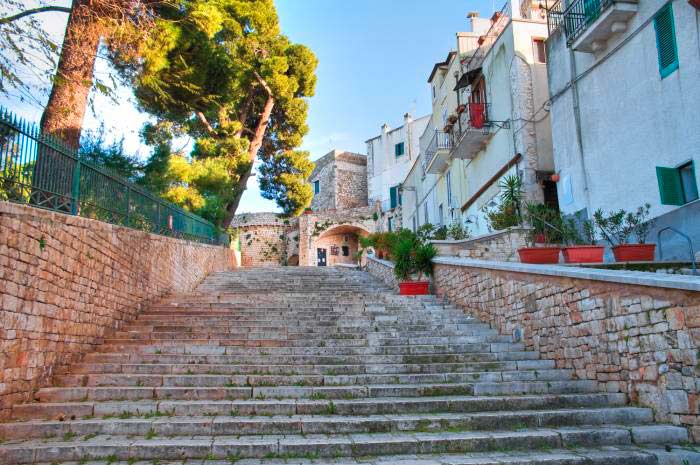
In reality, the figure of Guercio remains incomplete without mentioning the patronage of his court. It was certainly a specific political program, aimed at increasing the prestige of the family. However Giangirolamo and his wife Isabella enriched the family collection which with them came to count over five hundred paintings and various other works of art, including furniture and furnishings; they also gave hospitality to the painter Paolo Finoglio, who in the long stay in Conversano (1622-1645) was the author of various works: from the frescoes in the bedroom of the spouses, to the ten large canvases of the cycle inspired by the liberated Jerusalem, both housed in the castle, to the sumptuous decorations in the city churches of Carmine and Santi Cosma and Damiano which were built in those years.
Anche la costruzione dei trulli di Alberobello fu un espediente di Giangirolamo per eludere l’editto vicereale che richiedeva l’assenso della corte per la fondazione delle città: grazie alla particolare tecnica costruttiva a secco, ogni volta che si approssimava l’ispezione regia il Guercio poteva dare ordine di distruggere i tetti delle abitazioni, che in seguito sarebbero stati ricostruiti agevolmente.
Do you want to visit Conversano and save on the price of the B&B? Check our availability and ask for a discount!
Megalithic walls
An important fortification work around the hill where the city once stood dates back to the 6th century BC, when the town of Norba reached the apex of power and wealth. This wall, largely incorporated in subsequent constructions but sometimes visible on the ordinary wall fabric, was formed by huge parallelepiped boulders with an average section of 0.60 meters and length of 1.60, superimposed with a dry technique so as to form thick walls up to 4 meters. 790 meters long, the megalithic walls enclose an area of 4.75 hectares. There are still sections of the walls in some areas of the historic center. They have all the characteristics of the Pelasgians’ buildings, and we are told that Conversano built on those walls is to be considered a rebuilding of a destroyed city, much older and founded by the Pelasgians 18 centuries BC; era in which they emigrated from the east to Puglia.
Castle
The Conversano Castle stands on the highest point of the hill on which the city stands, in a position capable of dominating the entire surrounding area up to the sea, and delimits the ancient largo della Corte, a large square with an irregular shape always the fulcrum of city life.

Of the castle, which today looks like a stone citadel made up of buildings belonging to different eras and architectural tastes, one can now appreciate the impregnable aspect, now the refinement of the elegant rooms later on. It was the residence of the Counts of Conversano for almost seven centuries, since the Norman era. However, its history is much older: probably already at the time of the Greek-Gothic war (6th century AD). On the same place there was a defense building that incorporated a section of the megalithic walls of the ancient city of Norba.
Certainly the first Norman feudal lords imposed in the 11th century the reconstruction of a manor on the ruins of the previous one. A square-based tower, known as the Maestra Tower, and a fresco placed on the vault of the original entrance, depicting Saints Cosma and Damiano, remain today of the original Norman nucleus. Subsequently, important expansion works were carried out, among others, by the Luxembourg counts (14th century) who promoted the construction of the high circular tower at the north corner, right where the crest of the acropolis became steeper. Around 1460, the Acquavivas built a tower with a dodecagonal base, more squat and with escarpment walls, particularly daring from an engineering point of view: inside, in fact, there is a cistern around which a corridor equipped with machicolations, essential for the defense of the city.
The following centuries saw the further transformation of the building which gradually lost the characteristics of the manor to become an elegant stately home, suitable for the prestige of the powerful feudal lords. The current entrance opens along the boundary wall on Piazza Conciliazione, built in 1710 at the behest of Countess Dorotea Acquaviva. It is thus possible to access an internal courtyard which in turn guarantees access to the late Renaissance portico. Further interventions on the building complex followed one another until the end of the nineteenth century.
Currently the castle is only partially acquired to the municipal heritage, while some wings – including the bridal chamber decorated with scenes from the Old Testament by Paolo Finoglio – are still private property. In the public area of the building today there is the Civic Art Gallery which exhibits the large canvases of the Jerusalem Liberata cycle, also by Finoglio.
Nel territorio di Conversano, fuori dell’abitato, si può visitare la Riserva Naturale Regionale Orientata Laghi di Conversano e Gravina Monsignore: dieci doline carsiche, accogliendo l’acqua piovana, si trasformano in suggestivi laghetti; la gravina di Monsignore è invece un’incisione carsica che si estende dall’estrema Murgia di sud-est fino alla costa. Ammirate il paesaggio fatto di boschi, pascoli, campi e uliveti, e disseminato di antichi segni di insediamento come muretti a secco, ‘casedde’ e ‘specchie’.
the Laghi di Conversano and Gravina Monsignore Regional Nature Reserve: ten karst sinkholes, welcoming rainwater, are transformed into suggestive lakes; the gravina di Monsignore is instead a karst incision that extends from the extreme south-east Murgia to the coast. Admire the landscape made of woods, pastures, fields and olive groves, and scattered with ancient signs of settlement such as dry stone walls, ‘casedde’ and ‘specchie’.
Lungo la strada provinciale che unisce Conversano con Putignano, a circa 6 km dal centro si trova il Castello di Marchione. La costruzione era utilizzata come riserva di caccia dagli Acquaviva d’Aragona, abitualmente residenti nel Castello della città. Tale luogo, esteso per circa 1.260 ettari, era circondato da un bosco di querce e dalla macchia mediterranea. Di questa ricca flora sopravvive oggi solo una quercia, antica di cinque secoli. Secondo una leggenda un passaggio segreto collega il Marchione col Castello di Conversano.
It is in this scenario that the numerous cultural events of Conversano take place, such as the feast of Sant’Antonio Abate (January 17) and the Cherry Festival (in June). Outside the city, however, the Marchione Castle and the suggestive lakes await you.
Where to sleep in Conversano?
Why visit Conversano?
The Norba Group was founded in 1976 in Conversano, a city of art in the province of Bari, at the instigation of Luca Montrone, who still chairs it today. Norba is the pre-Latin name of Conversano, a village built between the eighth and sixth centuries BC.
The Group has been operating for 40 years as a leader in the multimedia communication sector in Southern Italy.
Starting from 2010, during the experimentation that preceded the transition from the analogue to the digital system, the two thematic TVs of the Group were born: first TG Norba 24, TV all news, and then Radionorba Television, the first radio and television broadcast in Europe.
The new headquarters in Conversano, “The Heart”, which covers an area of over 3 thousand square meters, will have, among other things, a container for live events, digital rooms for the creation of digital content and 4 new studios for direct. The scenographies with a fluid and futuristic design, also created in collaboration with the creative division of Sky, will have a technological infrastructure consisting of over 100 square meters of high-resolution LEDs, 220 light fixtures, moving head projectors and 4K cameras, all managed by a mediaserver for the synchronization of audio, video and graphics lights.
Do you want to visit Conversano and save on the price of the B&B? Check our availability and ask for a discount!
RELATED ARTICLES
Agriturismo Masseria Alberotanza B&B e Ristorante a Conversano
Secondary phone: +393317271337
Email: info@masseriaalberotanza.it


